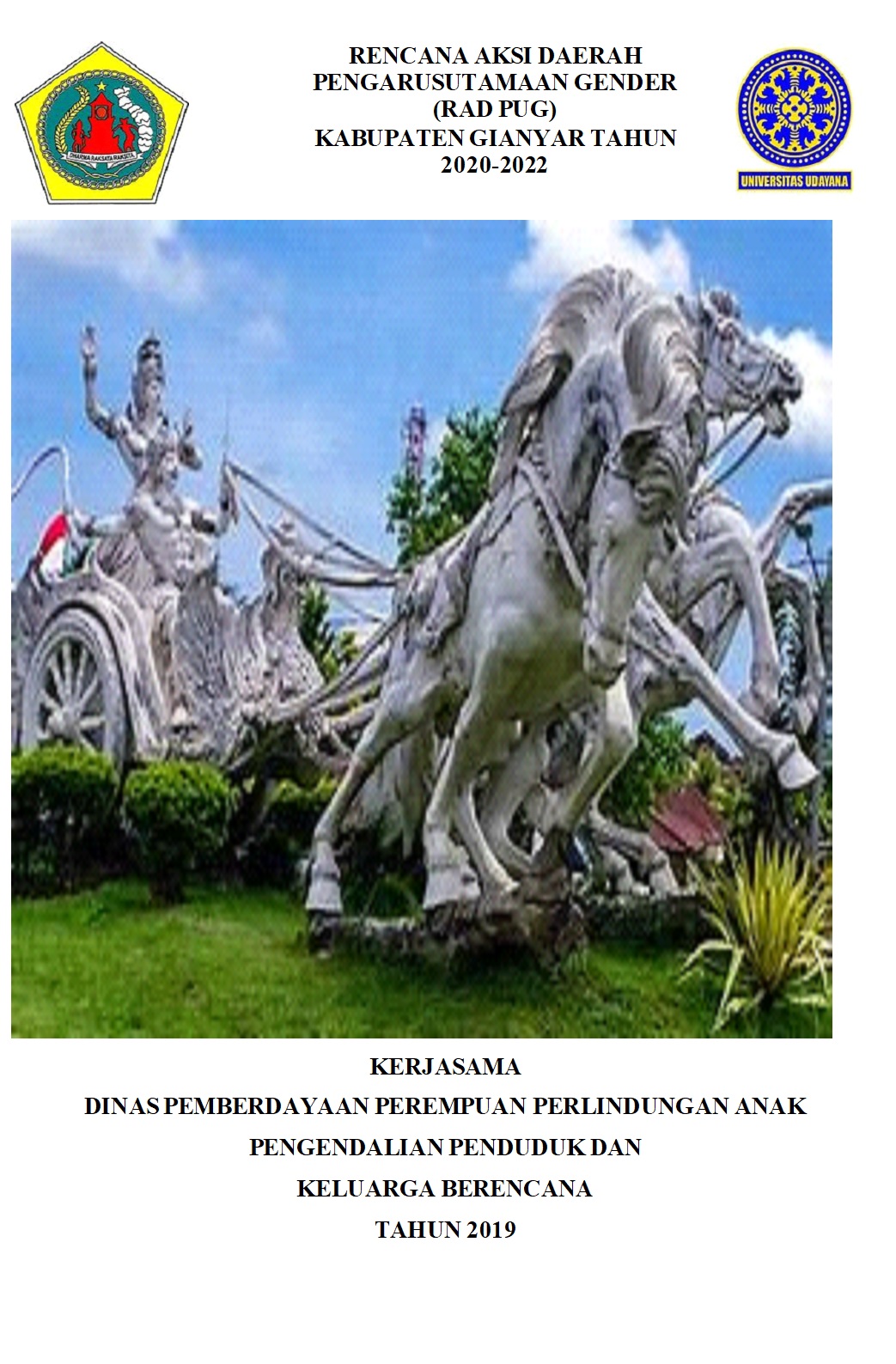
GENDER MAINSTREAMING ACTION PLAN (RAD PUG) OF GIANYAR DISTRICT, 2020-2022
NI LUH ARJANI; NI LUH ASTARI; WIDHIANTHINI; I WAYAN TAGEL EDY
ISBN : - Published : 2019
Abstrak
Until this moment the issue of gender and women's empowerment remains a strategic issue that requires serious handling, especially now that the issue of gender has become a global issue with the inclusion in the Millennium Development Divisions (MDGs) agreement launched by the United Nations in the Millennium Summit which then continues to sustainable development goals (SDGs) whose targets are achieved in 2030.
Of the 17 SDGs targets, gender equality and women's empowerment remain one of the goals targeted to be achieved in 2030. This means that every country that has signed the agreement must be able to tackle the issue by 2030. Indonesia as one of the participating countries In the declaration of the agreement, it is also required to be able to handle 17 goals, one of which is to be able to realize gender equality and women's empowerment in 2030. Therefore, the Indonesian government certainly cannot remain silent in order to achieve this target.
To be able to realize gender equality and women's empowerment is not an easy matter considering this is closely related to the socio-cultural construction that has been embedded since the birth of Adam and Eve on this earth. However, that does not mean we have to give up, because everything made by humans is nothing static but all can be changed and corrected. Of course this requires commitment and struggle that is serious and comprehensive, so it is very necessary to have support from all parties, both the community and related institutions.
Historically, efforts to fight for gender equality and women's empowerment have been carried out by the Indonesian government since the 70s, which began with the formation of a young minister for women's role (UPW) in 1978 which has now been transformed into the Ministry of Women's Empowerment and Child Protection. Besides that, legally, the 1945 Constitution has also mandated the principle of equality between men and women which explains the guarantee of the rights of every citizen to enjoy and participate in development in various fields, but in fact gender disparities in various development fields still occur. This means that there are still people who do not have access, have not participated, do not have control over resources and receive the results and benefits of development equally.
In line with global norms and agreements, where Indonesia also signed CEDAW and the Beijing Platform for Action (BPFA) and made gender mainstreaming (PUG) a strategy in realizing Gender Justice and Equality (KKG). In 2000, the President of Indonesia issued Presidential Instruction Number 9 of 2000 concerning PUG in National Development instructing all central and regional government agencies to incorporate gender dimensions into their policies, programs and activities. The Presidential Instruction saves all Ministers, Institution Heads, Governors and Regents / Mayors to integrate PUG at every stage of the development process, starting from planning and budgeting, implementation, monitoring and evaluation of policies, programs and activities. In addition, the implementation of PUG in the regions has also been strengthened by Regulation of the Minister of Home Affairs Number 67 of 2011 concerning general guidelines for implementing Gender Mainstreaming in the regions which clearly provides instructions on how PUG is applied in regional development planning.
Now, after 20 years running it turns out that the implementation of Presidential Instruction number 9 of 2000 which is the implementation of PUG has not been running optimally. In terms of substance, structure and culture, there are still some problems found as to why the implementation of PUG has been slow and unsuccessful, including the following:
a. In terms of substance. The results of interviews and field observations conducted showed that most planners and policy makers in several DPOs did not understand the substance of Presidential Instruction 9 of 2000 clearly about: (i) what is meant by PUG; (ii) how to apply PUG in program planning, activities and budget allocation, because the Inpres only provides general methods; (iii) lack of gender skills and sensitivity; (iv) what are the benefits of implementing GM; (v) what are the losses from not implementing PUG; and (vi) what indicators measure the successful implementation of PUG.
b. In terms of structure: The results of the evaluation of the PUG implementation show that: (i) many OPD planning officials do not yet know of the existence of Presidential Instruction 9 of 2000; (ii) planners are aware of Presidential Instruction no. 9 of 2000 and Permendagri No. 67 of 2011 but its application is not understood correctly; (iii) lack of leadership commitment in the implementation of PUG, this is due to: (a) lack of understanding or lack of clarity of substance, (b) lack of understanding
